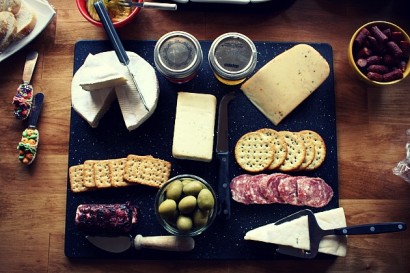No Reviews
You must be logged in to post a review.

Everyone loves cheese. And because I’m French, I especially love cheese. Ah, le fromage!
I wanted to pay homage to the art of the cheese board. A cheese board is so much more than just cutting up some bricked cheddar and mozzarella, putting out some crackers, and setting it on the table. I mean, that’s just cheese and crackers, plain and simple.
Note: The above ingredients are interchangeable. These are the ingredients from the cheese board I made.
Cheese boards should be carefully planned—from flavours to positioning. I will start off by saying that I strongly recommend avoiding chalkboard painted surfaces for your food. I know it looks pretty and rustic, with the chalkboard writing in front of each item to identify it. But it’s not healthy. Lead, people. Lead. So, unless you have your food sitting on top of something protective, or unless you have a death wish, avoid the chalkboards. Wooden planks are ideal, but large, plain cutting boards can work, too.
When it comes to choosing your cheese, you want balance in every which way. Different flavours from mild to strong; different textures; varying colours; an assortment of shapes.
The sort of arrangement I like to follow when it comes to cheese boards is this: Something ‘old’, something ‘new’, something ‘smoked’, something ‘goo’. Follow whatever arrangement you’d like; I’ll just exemplify mine.
Aged cheeses are easily recognized for their texture, odour, and taste. With age, cheese tends to become harder and more crumbly. The flavours are strong and salty, so a little goes a long way. Some good aged cheeses to consider are Cheddar (close to six months and up to seven years), Asiago (depending on the type, some Asiago is aged to three months, and others, all the way up to 18 months or more), Romano (5 to 12 months), Parmesan (10 to 24 months or more), Swiss (3 to 4 months), Gruyere (7 weeks to 3 months), and if you’re into blue, Roquefort (2 to 4.5 months) is decent, and even I can swing that one.
New cheese would be, well, basically the opposite of the aforementioned. Fresh, milky-white, light in body, texture, and flavour. They also have a much higher moisture content. Some nice new cheeses to consider are Chevre (goat cheese, which is offered in many different flavours, so you can have fun here), Mozzarella, Burrata, Marscapone, and Bocconcini.
Smoked cheese will be the death of me, because I could eat it until I burst. Smoked cheeses are, hands down, my favourite cheese. They make an impression on a cheese board, and man are they ever good in a fancy grilled cheese sandwich. Any smoked cheese is specially treated by smoke-curing, and as a result, it has a golden/brown outer pellicle. My personal favourite smoked cheeses are Smoked Cheddar, and Smoked Gouda. There are tons of different variations of smoked cheese, though. When it comes to arranging a cheese board, I’ll either go aged cheddar and smoked gouda, or aged gouda and smoked cheddar.
The whole ‘goo’ aspect of my cheese board arrangements typically come from Brie or Camembert, which get softer the longer they stand at room temperature. Though, any soft and velvety cheese will do the trick. I just like having this texture available – not to mention that Brie and Camembert pair very well with fancy jellies, honey, figs, and other delectable cheese board add-ons
If I have the room, I like to add a nice flavoured Havarti or Pepper Jack. With this particular cheese board, I chose a dill Havarti.
A cheese board certainly is ornamented with cheese, as the name suggests, but not cheese alone!
Sweet and salty accompaniments are a must, from crackers and mini-toasts to artisan breads, nuts, olives, meats, and jams! Choose accompaniments that best suit the cheeses you’ve chosen.
Aged cheeses are wonderful on their own, but they also pair wonderfully with salty goodies like Greek olives and cured meats, and they balance nicely on artisan breads or plain-tasting crackers.
New cheeses are more flexible when it comes to flavoured pairings. Seedy and/or flavoured crackers can really accentuate a mild and smooth mozzarella or plain chevre. Though, you could also jazz these up with drizzles of balsamic vinaigrette or a chutney of some sort. Adding some heat with hot peppers can also be a nice option. The milkiness of a fresh cheese can take the intensified heat of a hot pepper and really smooth it out.
Smoked cheeses are very similar to aged cheeses when it comes to pairing. They go great with salty add-ons and breads/crackers that have mild flavours, allowing the smokiness to stand out
Brie and Camembert are fantastic, because they are so versatile. You can bake them in an oven-safe melting pot, or leave them at room temperature. Either way, they are delicious and pair amazingly with both sweet or spicy jams/chutneys, honey, maple syrup, nuts, fruits, etc. Some of my favourite combinations include:
Plain cracker/bread, brie/camembert, red pepper jelly
Plain cracker/bread, brie/camembert, figs, honey
Plain cracker/bread,brie/camembert, crushed nuts, maple syrup
Plain cracker/bread, brie/camembert, fig compote
Plain cracker/bread, brie/camembert, caramelized onions
And that’s about it. Not too complex, right? Pick your cheeses, pair up appropriate accompaniments in the form of meats, salts and sweets, some crackers and breads to place them on, and voila! You are a master in the art of the cheeseboard! Oh, and don’t forget the wine!
One Comment
Leave a Comment
You must be logged in to post a comment.
C. L. ( Cheryl ) "Cheffie Cooks" Wiser on 5.12.2014
Greetings Dana, Job well done! Your TK friend, Cheryl.